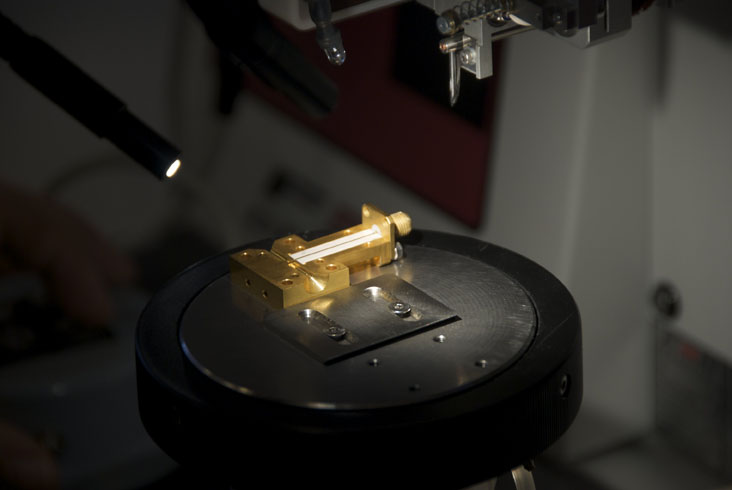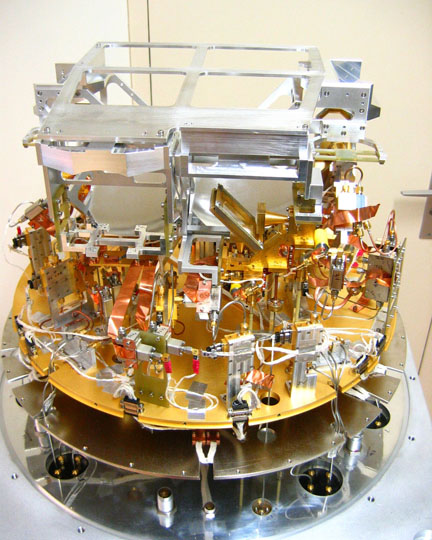IRAM's activities in the frame of the European Research Program RadioNet
IRAM is one of the major partners of the European Union’s “I3” Research Program RadioNet. RadioNet, which brings together most European laboratories involved in radio astronomical research, has been renewed in the frame of the 7th European Framework Program, FP7.
 It aims to optimise the instrumentation of the largest European radio telescopes (like receivers, spectrometers and tools for the processing of astronomical signals) and to make these telescopes accessible to all European scientists.
It aims to optimise the instrumentation of the largest European radio telescopes (like receivers, spectrometers and tools for the processing of astronomical signals) and to make these telescopes accessible to all European scientists.
The IRAM 30 meter telescope and the NOEMA interferometer – both of which are prime facilities for radio astronomy at millimeter (mm) wavelengths – are major elements of this program.
A fraction of the observing time that normally belongs to scientists of the IRAM funding countries (France, Germany and Spain) is therefore allocated to other European astronomers (from England, Italy, the Netherlands…) – provided that their observing projects have been judged “excellent”. In return, IRAM obtains from the European Commission financial support to cover parts of the instrument operating costs. The IRAM telescopes are also open to scientists from non-European countries, such as Americans and Japanese, as long as they submit top science proposals. Although IRAM receives no funding for it, the latter opening benefits to European astronomers since these countries open their own facilities in return, a common practice in astronomy. Outstanding results have been obtained over the last years with the IRAM telescopes: they range from the discovery in interstellar space of complex organic molecules and negative ions to pioneering studies of the chemical composition and structure of proto-planetary disks and to the detection of molecules such as hydrogen cyanide and isocyanide in high-redshift quasars.
The AMSTAR/AMSTAR+ Program
In addition to helping the Europeans observatories in their attribution of observing time to all European scientists, the European Commission funds through RadioNet four Research and Development Programs aimed at improving the instrumentation installed at the focii of radio telescopes. One of these programs, called AMSTAR, deals with high-sensitivity detectors operating at mm and sub-mm wavelengths.
 |
|
EMIR, one of the new generation receivers, during its final integration in the institute's research laboratories. |
IRAM’s in-house research and development activities linked to AMSTAR made it possible to develop a new generation of high-sensitivity detectors. Their most crucial components, super-conductor isolator super-conductor (SIS) junction mixers, are cooled by liquid helium down to – 269 C. They generate remarkably little noise and have very wide bandwidths. These fore-front mixers have already been incorporated into receivers in use at both IRAM observatories.
The AMSTAR program (now called AMSTAR+) has been renewed for 3 more years in the frame of FP7. AMSTAR+ focuses on the miniaturization of mm detectors in order to allow the construction of large focal-plane arrays of detectors. Up to now, radio astronomical observations of spectral lines are mostly done using single-pixel detectors, which means that astronomers observe at a given instant only one tiny spot on the sky. Mapping extended cosmic sources, requires to scan their area by moving the telescope, increasing the time required to complete one observation. The development of multi-pixel detector arrays (similar in their principle to small CCD cameras) will allow the observation of a full image in one single shot, hence reducing considerably the time needed to map sources.
The technical research activities linked to AMSTAR/AMSTAR+ together with IRAM’s other in-house developments are at the heart of the cutting-edge instrumentation available at the IRAM telescopes.

